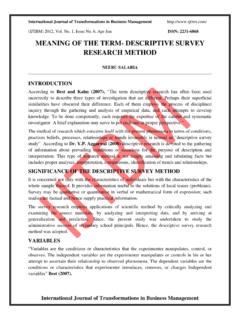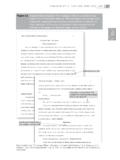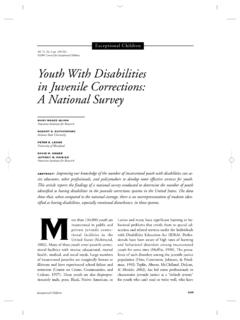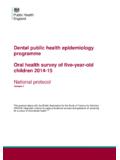Transcription of Regular article How are addicted physicians …
1 Regular articleHow are addicted physicians treated ? a national survey of physician health programsRobert L. DuPont, ( )a, A. Thomas McLellan, ( )b, , Gary Carr, ( )c,Michael Gendel, ( )c, Gregory E. Skipper, ( )caInstitute for Behavior and Health (IBH), Philadelphia, PA, 19106bThe Treatment Research Institute, Philadelphia, PA, 19106cFederation of State physician Health Programs (FSPHP), Philadelphia, PA, 19106 Received 23 March 2009; accepted 25 March 2009 AbstractIntroduction: physicians with substance use disorders receive care that is qualitatively different from and reputedly more effective thanthat offered to the general population, yet there has been no national study of this distinctive approach. To learn more about the nationalsystem of physician Health Programs (PHPs) that manage the care of addicted physicians , we surveyed all 49 state PHP medical directors(86% responded) to characterize their treatment, support, and monitoring :PHPs do not provide substance abuse authority from state licensing boards, state laws, and contractual agreements, they promote early detection, assessment, evaluation, andreferral to abstinence-oriented (usually) residential treatment for 60 to 90 days.
2 This is followed by 12-step oriented outpatient then receive randomly scheduled urine monitoring, with status reports issued to employers, insurers, and state licensing boards for(usually) 5 or more years. Outcomes are very positive, with only 22% of physicians testing positive at any time during the 5 years and 71%still licensed and employed at the 5-year : addicted physicians receive an intensity, duration, and quality of care that israrely available in most standard addiction treatments: (a) intensive and prolonged residential and outpatient treatment, (b) 5 years ofextended support and monitoring with significant consequences, and (c) involvement of family, colleagues, and employers in support andmonitoring. Although not available to the general public now, several aspects of this continuing care model could be adapted and used for thegeneral population. 2009 Elsevier Inc. All rights :Addiction treatment; Substance use disorders; physicians ' health programs1.
3 IntroductionAmong physicians , there is a lifetime prevalence ofsubstance use disorders (SUDs) of approximately 10% to12%, very similar to the general population rate (Flaherty &Richman, 1993; SAMHSA, 2006). Specialty care andsupervision for addicted physicians were initially proposedand initiated in 1973 by the American Medical Associationto help physicians and to protect the public with thepublication of The Sick physician : Impairment by Psychia-tric Disorders, Including Alcoholism and Drug Depen-dence. That document encouraged the growth ofspecialized, state physician Health Programs (PHPs) in 49states, managed via authority typically granted under charterfrom the state Licensing Boards, ..to provide advocacy forphysicians protect the public ( ; White, DuPont, & Skipper, in press).Given the potential public health and safety issuesassociated with addiction among physicians , it is surprisingthat despite the many studies of single-state PHPs ( ,Bohigan, Croughan, & Bondurant, 2002; Domino et al.)
4 ,Journal of Substance Abuse Treatment 37 (2009) 1 7 The Robert Wood Johnson Foundation supported this study but had norole in the design, conduct, analyses or even in the decision to submit thestudy for publication. Corresponding author. Treatment Research Institute, 600 PublicLedger Bld., 150 S. Independence Mall, Philadelphia, PA, McLellan).0740-5472/09/$ see front matter 2009 Elsevier Inc. All rights ; Fletcher, 2001; Reading, 1992; Selander & Epstein,1983), there has been no study describing the nationalprogram of PHPs or the nature of treatment and monitoringprovided. In this regard, it might be expected that physicianswith a SUD receive essentially the same type and duration oftreatment that other addicted individuals receive. This isgenerally the case in all other areas of health care. If so, thereis reason for concern because studies of addiction treatmentin the general population have consistently shown relapserates of 40% to 60% following treatment (Finney, Ouimette,Humphreys, & Moos, 2001; Institute of Medicine, 2006;McLellan, O'Brien, Lewis, & Kleber, 2000; ProjectMATCH, 1997; Simpson, Joe, & Brown, 1997).
5 However, it appears that the care and management ofaddicted physicians , as coordinated through these PHPs,may be qualitatively and quantitatively different from thecare available to the lay public (seeDomino et al., 2005;Gold, Pomm, Kennedy, Jacobs, & Frost-Pineda, 2002;Skipper, 1997). Moreover, the available outcome studies ofPHP-managed addicted physicians have reported remarkableresults much superior to those found in other populationsof addicted patients or from other forms of addictiontreatment. Specifically, one outcome study reported absti-nence rates of 78% over 11 years (Domino et al., 2005),whereas another reported a 90+% success rate over 5 years(Shore, 1987).Indications of qualitative differences in the way care isprovided, coupled with indications of substantially betterresults, led us to several evaluation questions. How do theseprograms operate? What is their structure? Are the programssimilar across states?
6 And What are the factors potentiallyresponsible for the widely reported better outcomes? Withthese questions in mind, we approached the Federation ofState physician Health Programs (FSPHP) to undertake acomprehensive, nationally representative evaluation of thestructure and function of these PHPs. Here, we characterizethe legal, financial, administrative, and clinical structure of42 PHPs nationwide, with a description of the course of care,support, and monitoring provided by these programs. Wereport some of the more salient 5-year results here, but asecond article (McLellan, DuPont, & Skipper, 2008)isdevoted to a full report of the 5-year outcomes on aconsecutive sample of more than 900 addicted physiciansfrom 16 state Involvement of the FSPHPThe FSPHP was approached with a request for assistance incompleting a descriptive survey of all state PHPs. A steeringcommittee involving members of seven PHPs was formed toadvise us on the content of the questionnaire and on the datacollection procedures.
7 The steering committee also encour-aged all PHPs to participate in this independent Questionnaire developmentFollowing Institutional Review Board approval, a 38-item questionnaire was sent to the Medical Directors of all49 active PHPs in April 2005. The questionnaire, pretestedby a small group of PHPs, was organized into threecontent areas: financial and legislative aspects of theorganization, physician participant profiles, and types ofservices survey proceduresQuestionnaire submission was followed by telephonecontact to promote participation, clarify questions, andassure understanding of responses. Complete question-naires were received from 39 of 49 PHPs, and anadditional three partially completed questionnaires wereobtained from 3 others for an 86% response rate. Allreturned questionnaires were examined by independentresearch staff for completeness and consistency. Blank orconfusing responses were resolved by calls from theauthors to verify understanding of the question and thevalidity of the PHP goalsAll responding PHPs shared the common goals of earlydetection of SUDs, thorough assessment and evaluation ofpotential cases, referral to abstinence-based treatment, long-term contingency monitoring, and reporting monitoringresults to credentialing agencies ( , medical groups,hospitals, malpractice companies, health insurance compa-nies, and so on) concerned with assuring that physicians areable to practice with reasonable skill and safety.
8 There wasessentially complete uniformity of these goals across allsurveyed OrganizationMost PHPs were independent, nonprofit foundations(54%), and the others were components of the state medicalassociation (35%) or the licensing board itself (13%).Regardless of the organizational charter, all PHPs hadwritten operating agreements with their state licensingboards to act on their behalf in the management of addictedphysicians, and 59% of these PHPs had independent legalauthority based on specific state PersonnelThe average number of paid, full-time equivalentemployees per PHP averaged 5 (range = 1 19,Mdn=3)including medical directors, clerical support, administrators,counselors, and case DuPont et al. / Journal of Substance Abuse Treatment 37 (2009) 1 BudgetThe average annual operating budget for a PHP wasapproximately $538,000, although this varied substantially(range = $21,250 $ million,Mdn= $270,000).
9 Thesources for these operating funds included licensing boards(50%), participant fees (16%), state medical association(10%), hospital contributions (9%), malpractice companies(6%), and other (9%). These PHP budgets didnotincludemost treatment or drug testing, which were borne by theparticipants themselves. About half of programs received atleast part of their funding from participants, but the other halfcharged nothing to General servicesAll PHPs provided general addiction education programsfor all physicians in their state, as well as consultation withhospitals and clinics, informal investigations, careful evalua-tion of addiction treatment programs as referral sites, andmost importantly, long-term monitoring. As part of theirgeneral services (both to the state licensing boards as well asto the physician participants), all PHPs maintained recordsdocumenting participant abstinence (drug testing and work-site surveillance) and participation in the various therapeuticand monitoring aspects of the program.
10 These records wereregularly provided to the licensing boards, hospitals, andmalpractice carriers who required this evidence as a conditionof participants' continued ability to practice Description of addicted physiciansPHPs reported admitting an average of 34 new physicianswith SUDs per year, per program (range = 0 150 cases,Mdn= 21). PHPs reported an average active caseload of138 physicians under monitoring contracts (range = 9 541,Mdn= 86). Although all PHPs dealt with SUDs, only 12%focused exclusively on those problems. Most also workedwith physicians who have mental illness (85%), physicalillness (62%), and other potentially impairing conditions (forexample cognitive deterioration). About a third (36%)handled only physicians , whereas the remainder also dealtwith other health care professionals such as dentists (51%),veterinarians (33%), and pharmacists (21%). Referral sources and conditionsThe four major sources of referrals to PHPs in 2005 wereself-referrals (26%), clinical colleagues (20%), the statelicensing board (21%), and the hospital medical staff (14%).






